Analysis of the Role of Water Saturation Degree in HTO, 36Cl, and 75Se Diffusion in Sedimentary Rock
Abstract
1. Introduction
2. Materials and Methods
2.1. Characterization of Rock and Sample Preparation
2.2. Equilibrium Water
2.3. Tracers
2.4. Experimental Set-Up of Diffusion Tests
2.4.1. Through-Diffusion Method (TD)
2.4.2. Instantaneous Planar Source Method (IPS)
3. Results and Discussion
3.1. Through-Diffusion Test
3.2. Instantaneous Planar Source Tests with HTO and 36Cl
3.3. Instantaneous Planar Source Tests with 75Se(IV)
4. Conclusions
Supplementary Materials
Author Contributions
Funding
Data Availability Statement
Acknowledgments
Conflicts of Interest
References
- Aldaba, D.; García-Gutiérrez, M.; Rigol, A.; Vidal, M. Comparison of laboratory methodologies for evaluating radiostrontium diffusion in soils: Planar-source versus half-cell methods. Sci. Total Environ. 2010, 408, 5966–5971. [Google Scholar] [CrossRef] [PubMed]
- Sellin, P.; Leupin, O.X. The use of clay as an engineered barrier in radioactive-waste management—A review. Clays Clay Miner. 2013, 61, 477–498. [Google Scholar] [CrossRef]
- Armand, G.; Djizanne, H.; Zghondi, J.; de La Vaissière, R.; Talandier, J.; Conil, N. Inputs from in situ experiments to the understanding of the unsaturated behavior of Callovo-Oxfordian claystone. In Proceedings of the 3rd European Conference on Unsaturated Soils, Paris, France, 12–14 September 2016; Volume 9. [Google Scholar] [CrossRef]
- Matray, J.M.; Savoye, S.; Cabrera, J. Desaturation and structure relationships around drifts excavated in the well-compacted Tournemire’s argillite (Aveyron, France). Eng. Geol. 2007, 90, 1–16. [Google Scholar] [CrossRef]
- Mayor, J.C.; Velasco, M.; García-Siñeriz, J.L. Ventilation experiment in the Mont Terri underground laboratory. Phys. Chem. Earth 2007, 32, 616–628. [Google Scholar] [CrossRef]
- Van Loon, L.R.; Soler, J.M.; Bradbury, M.H. Diffusion of HTO, 36Cl− and 125I− in Opalinus Clay samples from Mont Terri: Effect of confining pressure. J. Contam. Hydrol. 2003, 61, 73–83. [Google Scholar] [CrossRef]
- Garcia-Gutiérrez, M.; Cormenzana, J.L.; Missana, T.; Mingarro, M. Diffusion coefficients and accessible porosity for HTO and 36Cl− in compacted FEBEX bentonite. Appl. Clay Sci. 2004, 26, 65–73. [Google Scholar] [CrossRef]
- Wu, T.; Wang, H.; Zheng, Q.; Zhao, Y.L.; Van Loon, L.R. Diffusion behavior of Se(IV) and Re(VII) in GMZ bentonite. Appl. Clay Sci. 2014, 101, 136–140. [Google Scholar] [CrossRef]
- Wang, C.; Myshkin, V.F.; Khan, V.A.; Panamareva, A.N. A review of the migration of radioactive elements in clay minerals in the context of nuclear waste storage. J. Radioanal. Nucl. Chem. 2022, 331, 3401–3426. [Google Scholar] [CrossRef]
- García-Gutiérrez, M.; Cormenzana, J.L.; Missana, T.; Mingarro, M.; Molinero, J. Overview of laboratory methods employed for obtaining diffusion coefficients in FEBEX compacted bentonite. J. Iberian Geol. 2006, 32, 37–53. [Google Scholar]
- Medved, I.; Cerny, R. Modeling of radionuclide transport in porous media: A review of recent studies. J. Nucl. Mater. 2019, 526, 151765. [Google Scholar] [CrossRef]
- Cormenzana, J.L.; García-Gutiérrez, M.; Missana, T.; Junghanns, Á. Simultaneous estimation of effective and apparent diffusion coefficients in compacted bentonite. J. Contam. Hydrol. 2003, 61, 63–72. [Google Scholar] [CrossRef]
- Shackelford, C.D.; Moore, S.M. Fickian diffusion of radionuclides for engineered containment barriers: Diffusion coefficients, porosities, and complicating issues. Eng. Geol. 2013, 152, 133–147. [Google Scholar] [CrossRef]
- Nunn, J.A.; Xiang, Y.; Al, T.A. Investigation of partial water saturation on diffusion in shale. Appl. Geochem. 2018, 97, 93–101. [Google Scholar] [CrossRef]
- Savoye, S.; Page, J.; Puente, C.; Imbert, C.; Coelho, D. New experimental approach for studying diffusion through an intact and unsaturated medium: A case study with Callovo-Oxfordian argillite. Environ. Sci. Technol. 2010, 44, 3698–3704. [Google Scholar] [CrossRef]
- Savoye, S.; Beaucaire, C.; Fayete, A.; Herbette, M.; Coelho, D. Mobility of Cesium through the Callovo-Oxfordian claystones under partially saturated conditions. Environ. Sci. Technol. 2012, 46, 2633–2641. [Google Scholar] [CrossRef]
- Hu, Q.; Wang, J.S. Aqueous-Phase Diffusion in Unsaturated Geologic Media: A Review. Cri. Rev. Environ. Sci. Technol. 2003, 33, 275–297. [Google Scholar] [CrossRef]
- Van Loon, L.R.; Glaus, M.A.; Müller, W. Anion exclusion effects in compacted bentonites: Towards a better understanding of anion diffusion. Appl. Geochem. 2007, 22, 2536–2552. [Google Scholar] [CrossRef]
- Bourke, P.J.; Jefferies, N.L.; Lever, D.A.; Lineham, T.R. Mass transfer mechanisms in compacted clays. In Geochemistry of Clay-Pore Fluid Interactions; Manning, D.A.C., Hall, P.L., Hughes, C.R., Eds.; Chapman & Hall: London, UK, 1993. [Google Scholar]
- Fernández, A.M.; Sánchez-Ledesma, D.M.; Melón, A.M.; Robredo, L.M.; Labajo, M.A.; Sánchez, M.; Claver, M.A.; González, A.E.; Gutiérrez-Nebot, L. Síntesis geoquímica, mineralógica y petrográfica del sustrato geológico del ATC: Características de las unidades litoestatigráficas LBS, YB, LB1 y UI en el entorno de Villar de Cañas (Cuenca). Internal Report: CIEMAT/DMA/2G214/01/16. 2016.
- Descostes, M.; Blin, V.; Bazer-Bachi, F.; Meier, P.; Grenut, B.; Radwan, J.; Schlegel, M.L.; Buschaert, S.; Coelho, D.; Tevissen, E. Diffusion of anionic species in Callovo-Oxfordian argillites and Oxfordian limestones (Meuse/Haute-Marne, France). Appl. Geochem. 2008, 23, 655–677. [Google Scholar] [CrossRef]
- Crank, J. The Mathematics of Diffusion, 2nd ed.; Clarendon Press: Oxford, UK, 1975. [Google Scholar]
- Altmann, S.; Tournassat, C.; Goutelard, F.; Parneix, J.C.; Gimmi, T.; Maes, N. Diffusion-driven transport in clayrock formations. Appl. Geochem. 2012, 27, 463–478. [Google Scholar] [CrossRef]
- Churakov, S.V. Mobility of Na and Cs on montmorillonite surface under partially saturated conditions. Environ. Sci. Technol. 2013, 47, 9816–9823. [Google Scholar] [CrossRef]
- Savoye, S.; Schlegel, M.L.; Frasca, B. Mobility of selenium oxyanions in clay-rich media: A combined batch and diffusion experiments and synchrotron-based spectroscopic investigations. Appl. Geochem. 2021, 128, 104932. [Google Scholar] [CrossRef]
- Masscheleyn, P.H.; Delaune, R.D.; Patrick, W.H. Transformation of Se as affected by sediment oxidation-reduction potential and pH. Environ. Sci. Technol. 1990, 24, 91–96. [Google Scholar] [CrossRef]
- Beauwens, T.; De Canniêre, P.; Moors, H.; Wang, L.; Maes, N. Studying the migration behaviour of selenite in Boom Clay by electromigration. Eng. Geol. 2005, 77, 285–293. [Google Scholar] [CrossRef]
- Missana, T.; Alonso, U.; García-Gutiérrez, M. Experimental study and modelling of selenite sorption onto illite and smectite clays. J. Colloid Interface Sci. 2009, 334, 132–138. [Google Scholar] [CrossRef]
- Lin, J.; Chen, N.; Feng, R.; Nilges, M.J.; Jia, Y.; Wang, S.; Pan, Y. Sequestration of Selenite and Selenate in Gypsum (CaSO4·2H2O): Insights from the Single-Crystal Electron Paramagnetic Resonance Spectroscopy and Synchrotron X-ray Absorption Spectroscopy Study. Environ. Sci. Technol. 2020, 54, 3169–3180. [Google Scholar] [CrossRef]
- Wu, T.; Dai, W.; Xiao, G.; Shu, F.; Yao, J.; Li, J. Influence of dry density on HTO diffusion in GMZ bentonite. J. Radioanal. Nucl. Chem. 2012, 292, 853–857. [Google Scholar] [CrossRef]
- Kozaki, T.; Fujishima, A.; Saito, N.; Sato, S.; Ohashi, H. Effects of dry density and exchangeable cations on the diffusion process of sodium ions in compacted montmorillonite. Eng. Geol. 2005, 81, 246–254. [Google Scholar] [CrossRef]
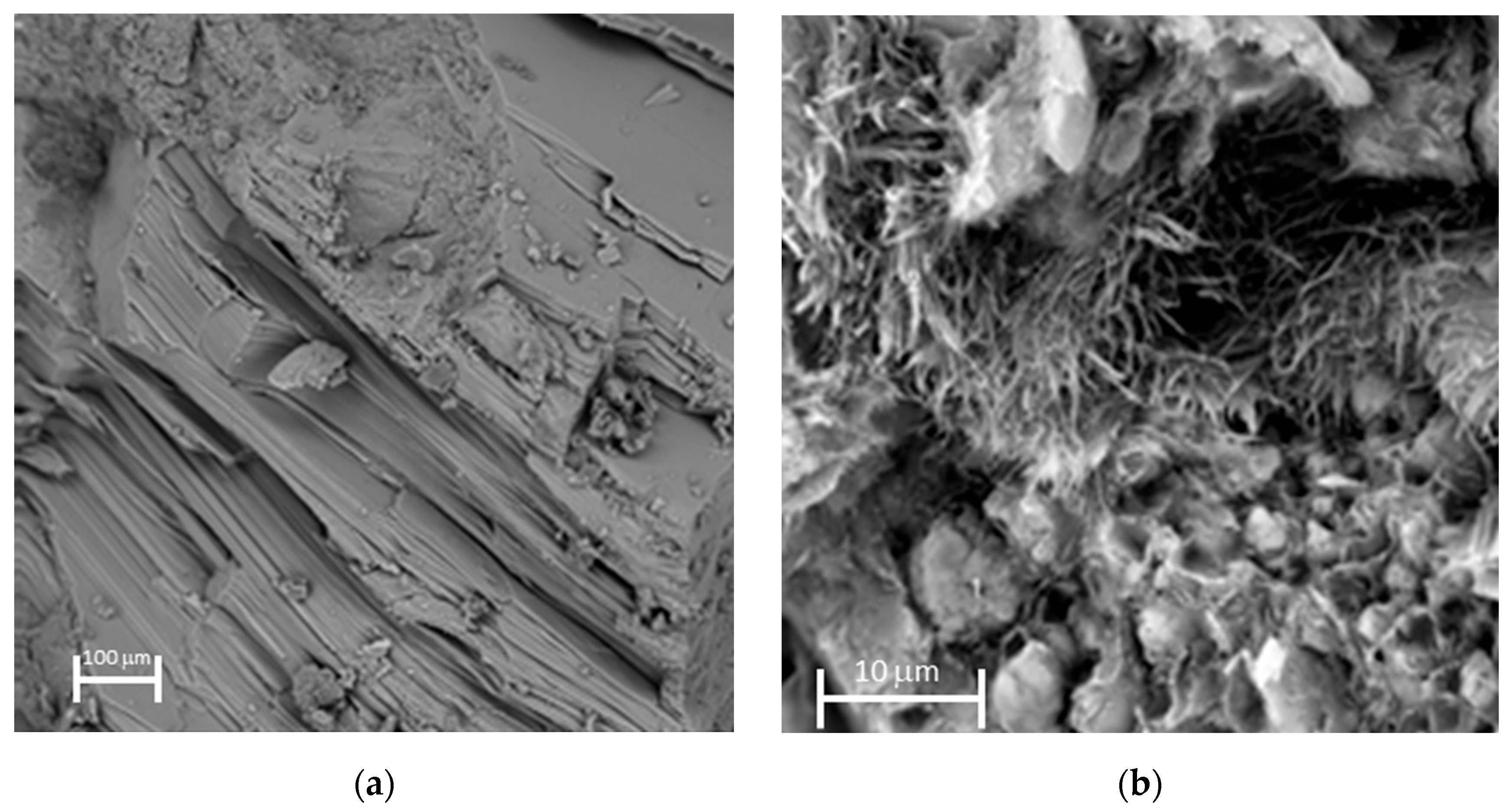
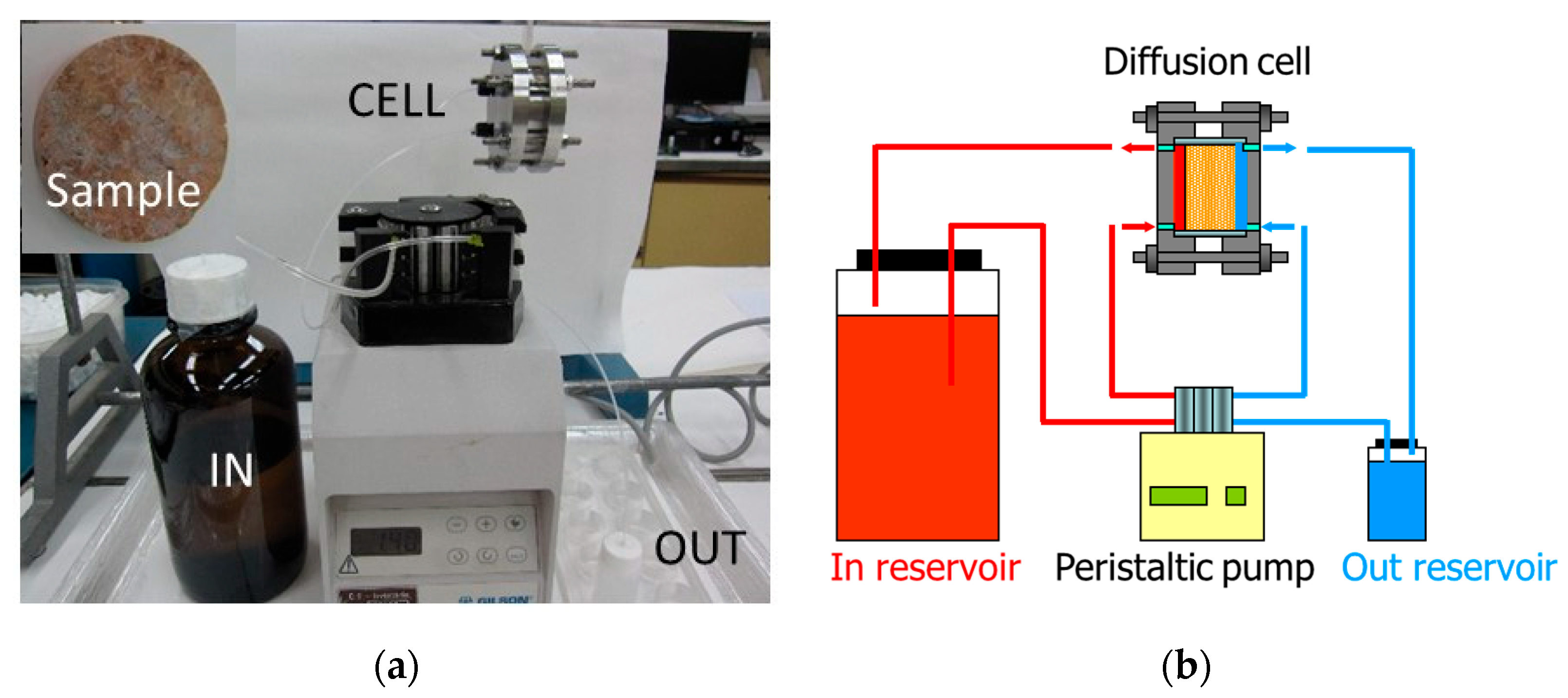

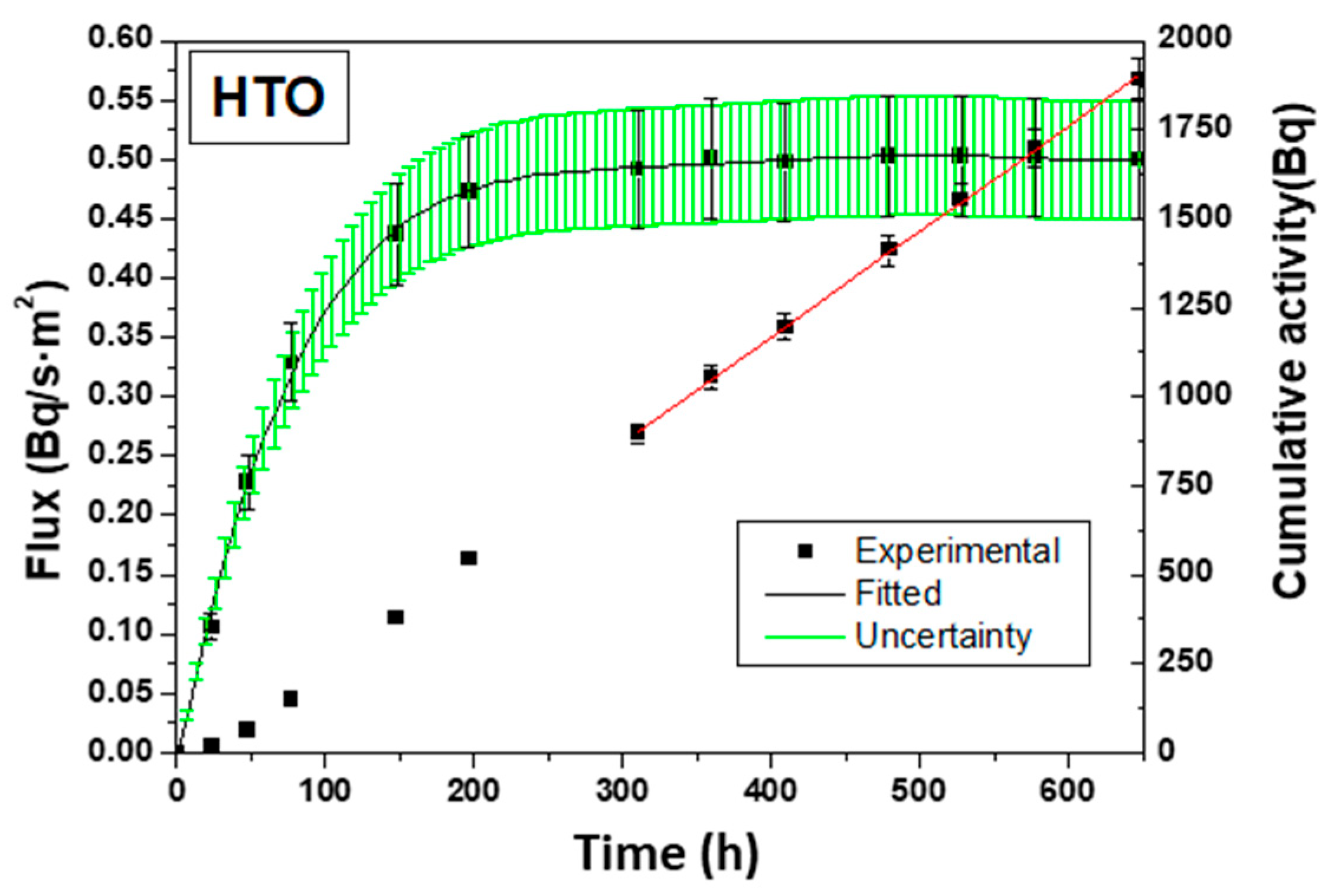


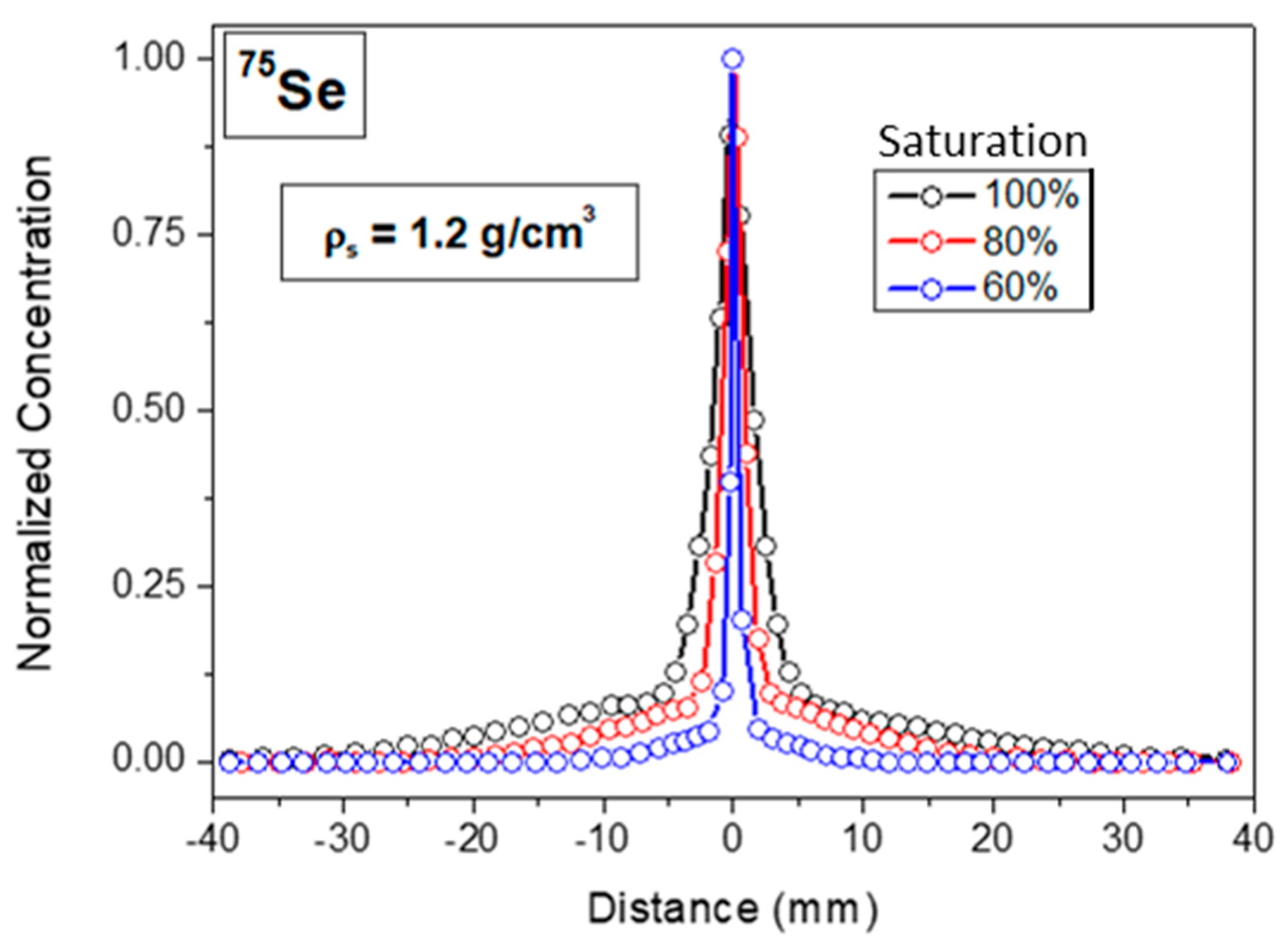
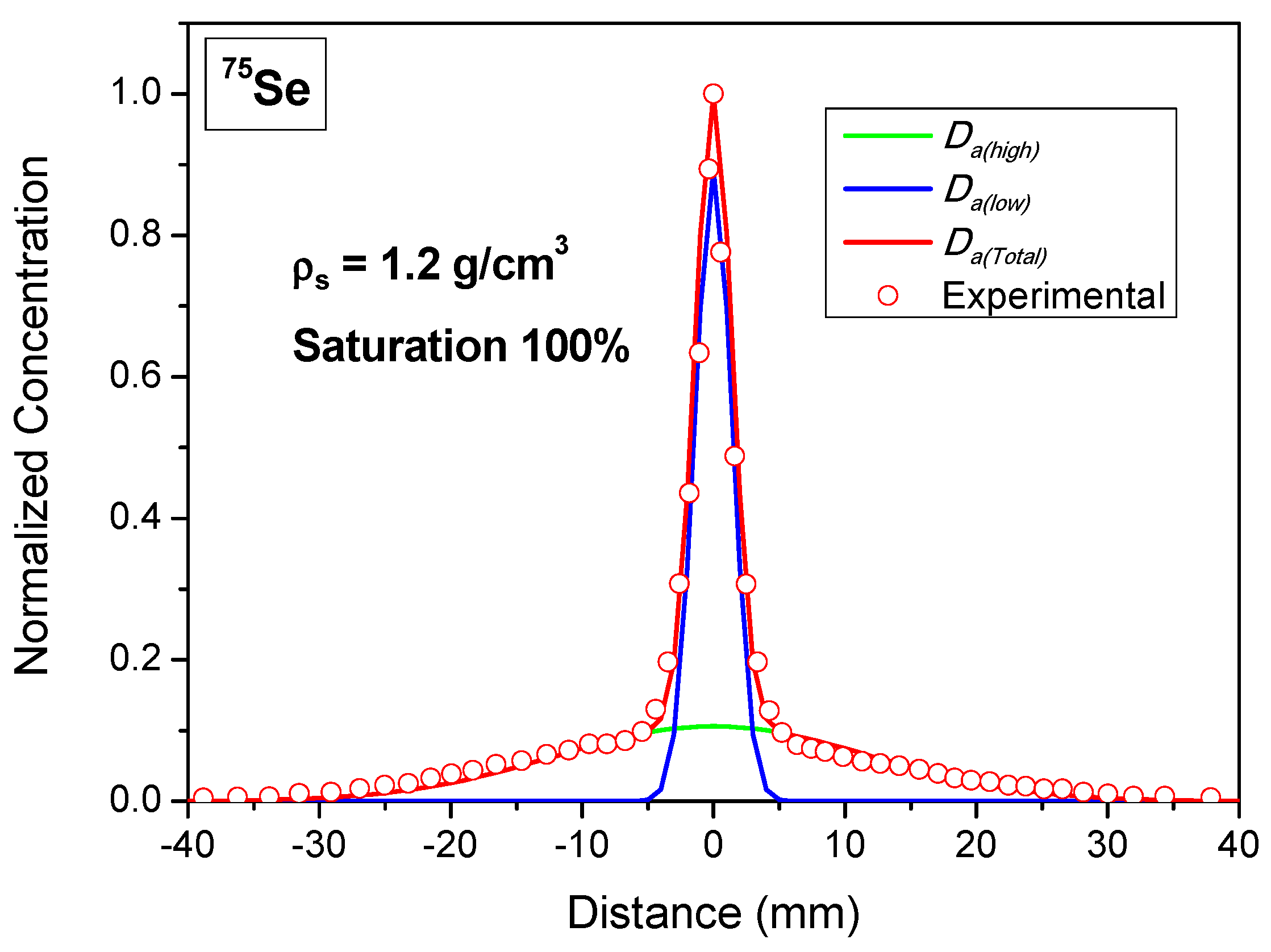
| Element | mol/L |
|---|---|
| Cl− | 1.52 × 10−5 |
| HCO3− | 1.51 × 10−4 |
| SO42− | 1.35 × 10−2 |
| Ca2+ | 1.30 × 10−2 |
| Mg2+ | 2.60 × 10−4 |
| Na+ | 8.70 × 10−5 |
| K+ | 4.10 × 10−5 |
| SiO2 | 5.33 × 10−5 |
| pH | 8.13 |
| Cond. (μS/cm) | 1988 |
| HTO | 36Cl | |
|---|---|---|
| De (m2/s) Parallel | (1.1 ± 0.2) × 10−10 | (6.3 ± 0.1) × 10−11 |
| De (m2/s) Perpendicular | (9.3 ± 0.1) × 10−11 | (5.1 ± 0.1) × 10−11 |
| Anisotropy factor | 1.18 ± 0.22 | 1.23 ± 0.14 |
| α | 0.17 ± 0.01 | 0.07 ± 0.01 |
| Saturation Degree (%) | Da (m2/s) HTO | Da (m2/s) 36Cl |
|---|---|---|
| 100 | (1.5 ± 0.1) × 10−9 | (4.6 ± 0.2) × 10−10 |
| 90 | (4.3 ± 0.1) × 10−10 | (1.0 ± 0.1) × 10−10 |
| 80 | (3.7 ± 0.1) × 10−10 | (5.4 ± 0.4) × 10−11 |
| 70 | (2.9 ± 0.1) × 10−10 | (5.2 ± 0.4) × 10−11 |
| 60 | (2.3 ± 0.1) × 10−10 | (2.8 ± 0.1) × 10−11 |
| S (%) | 1.2 g/cm3 | 1.4 g/cm3 | 1.65 g/cm3 | |||
|---|---|---|---|---|---|---|
| High | Low | High | Low | High | Low | |
| 100 | (2.0 ± 0.4) × 10−10 | (2.9 ± 0.2) × 10−12 | (1.0 ± 0.3) × 10−10 | (9.0 ± 0.1) × 10−13 | (3.6 ± 1.2) × 10−11 | (2.5 ± 0.2) × 10−13 |
| 90 | (1.7 ± 0.2) × 10−10 | (2.5 ± 0.1) × 10−12 | (7.2 ± 0.3) × 10−11 | (5.6 ± 0.1) × 10−13 | (1.5 ± 0.2) × 10−11 | (1.2 ± 0.1) × 10−13 |
| 80 | (8.2 ± 1.1) × 10−11 | (7.8 ± 0.3) × 10−13 | (4.4 ± 0.8) × 10−11 | (3.7 ± 0.2) × 10−13 | (4.3 ± 1.2) × 10−12 | (4.0 ± 0.3) × 10−14 |
| 70 | (5.2 ± 1.4) × 10−11 | (5.1 ± 0.4) × 10−13 | (1.6 ± 0.2) × 10−11 | (1.1 ± 0.1) × 10−13 | (1.9 ± 0.4) × 10−12 | (1.4 ± 0.4) × 10−14 |
| 60 | (1.5 ± 0.4) × 10−11 | (6.9 ± 0.2) × 10−14 | (5.3 ± 1.1) × 10−12 | (8.6 ± 0.5) × 10−14 | (8.3 ± 0.5) × 10−13 | (8.6 ± 0.5) × 10−15 |
Disclaimer/Publisher’s Note: The statements, opinions and data contained in all publications are solely those of the individual author(s) and contributor(s) and not of MDPI and/or the editor(s). MDPI and/or the editor(s) disclaim responsibility for any injury to people or property resulting from any ideas, methods, instructions or products referred to in the content. |
© 2023 by the authors. Licensee MDPI, Basel, Switzerland. This article is an open access article distributed under the terms and conditions of the Creative Commons Attribution (CC BY) license (https://creativecommons.org/licenses/by/4.0/).
Share and Cite
García-Gutiérrez, M.; Mingarro, M.; Morejón, J.; Alonso, U.; Missana, T. Analysis of the Role of Water Saturation Degree in HTO, 36Cl, and 75Se Diffusion in Sedimentary Rock. Minerals 2023, 13, 593. https://doi.org/10.3390/min13050593
García-Gutiérrez M, Mingarro M, Morejón J, Alonso U, Missana T. Analysis of the Role of Water Saturation Degree in HTO, 36Cl, and 75Se Diffusion in Sedimentary Rock. Minerals. 2023; 13(5):593. https://doi.org/10.3390/min13050593
Chicago/Turabian StyleGarcía-Gutiérrez, Miguel, Manuel Mingarro, Jesús Morejón, Ursula Alonso, and Tiziana Missana. 2023. "Analysis of the Role of Water Saturation Degree in HTO, 36Cl, and 75Se Diffusion in Sedimentary Rock" Minerals 13, no. 5: 593. https://doi.org/10.3390/min13050593
APA StyleGarcía-Gutiérrez, M., Mingarro, M., Morejón, J., Alonso, U., & Missana, T. (2023). Analysis of the Role of Water Saturation Degree in HTO, 36Cl, and 75Se Diffusion in Sedimentary Rock. Minerals, 13(5), 593. https://doi.org/10.3390/min13050593





